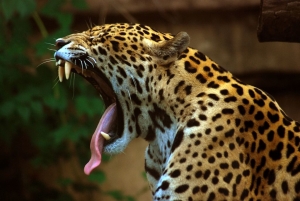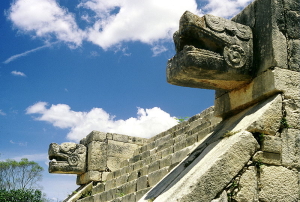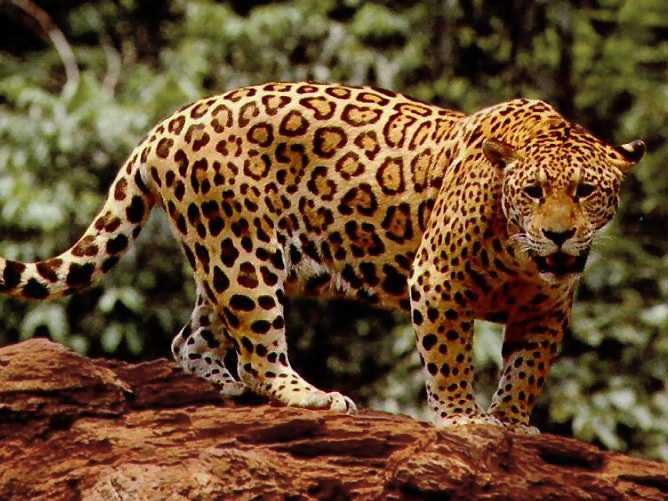Let’s just put it this way: Crocodiles are one of their prey species.
Jaguars are the baddest act in the jungle, and when there’s not an animal in your ecosystem who can take you down, it gives you personality issues. Picture it: You are the biggest cat in the Americas. You are the third biggest cat in the world. Those cougars and bobcats and lynxes in North America—they’re not even related to you. You’re in the genus Panthera, thank you very much. Your cousins are the lions of the African savanna and the tigers of Asia. When that ancestor of yours crossed the Bering land bridge to the Americas back in the Pleistocene era (along with a gifted ape called Homo sapiens), he was almost twice your size, and lived and fought in the megafauna world of mastodons and wooly mammoths, and God only knows what kind of predatory fights he got into, and actually the scientists don’t know either, but they generally call him “Panthera genus, species unknown”, which means that maybe 13,000 years later, he had become you: Panthera onca. Terror of the jungle. Apex predator in four different ecosystems. Deity of the Maya. The jaguar.
He’s in these forests. Let’s talk.
* * * *
Susan and I were lucky enough once to see a cougar (on a long night training run in Fort Ord), but it’s highly unlikely we’ll be fortunate enough to see a jaguar in our lifetimes. They are even more reclusive than the cougar, and they favor dense jungle. But you can hear them. Our friend Victoria hears them at night behind her house outside Tulum. They growl and roar, like lions, calling back and forth in the jungle. And we know a hiking guide near Puerto Vallarta who came around a bend in the trial once and found himself facing one. They stared at each other for most of a minute. He said it was the most focused his mind has ever been. Then the jaguar just turned and walked away.
But actually, in hindsight, our friend hadn’t been in any danger. Jaguars bring to mind that iconic line from the film The Godfather: If I wanted to kill you, you’d be dead. They’re ambush predators, not chase predators. They stay invisible to you until they are within a short charge or a single bound. You don’t even know you have a problem until he’s airborne. The rosettes on his coat are perfect for the dappled sunlight of deep forest, and even scientists who study big cats for a living say they’re remarkably skilled at this ambush-predator stuff.

A jaguar shows off the gape of his jaws
By MarcusObal [GFDL or CC BY-SA 3.0], via Wikimedia Commons
It is thought that this technique evolved because eleven thousand years ago (give or take a couple) there was an event called the Pleistocene Extinctions, in which we lost thirty-three of our forty-five genera of large mammals (those gifted apes I mentioned probably had a hand in this). For a while there it got pretty hard to find a mammal, but there were lots of armored reptiles around, like turtles and crocodiles, and also giant armadillos—if you could get through their armor.
They do kill livestock, and they’re strong enough to carry a young cow up a tree. One was observed dragging an 800-pound bull twenty-five feet across a pasture. And when they kill a horse, what they will often do is leap on its back, put one great paw on the muzzle, one on the nape of the neck, and then twist, like an evil chiropractor, dislocating the neck.
They love water. They like to be around rivers, they can catch fish in a pinch, and crocodile is one of their favorite foods. They will kill a crocodile by exploding out of the water like a crocodile. They can swim carrying a very large kill. They are also completely at home in the trees, and they can hunt arboreally. They can even make a go of it in habitats like arid grassland and seasonally flooded wetlands, but by far they prefer deep jungle. It’s what they’re built for. They’re not long-limbed and fleet-footed like their cousins on the savanna. That doesn’t work in dense jungle. They’re huge, but they’re compact—short-limbed and extremely muscular.
They are considered a keystone species. A keystone species is one which has a disproportionate influence on the ecosystem. It’s a reference to the keystone at the top of a stone arch. It carries less weight than any other stone, but remove it and the arch collapses. The jaguar is the apex predator. Remove him, and you get an over-abundance of the next predator down, and then a cascading re-shaping of the whole food chain.
They used to be common in the United States. Thomas Jefferson recorded their presence in 1799, and they were seen in California (Monterey is mentioned), as far north as Missouri and as far east as the Carolinas. They quickly got exterminated by Anglo-Americans, and the ones in the Southwest were the last to go. The last female jaguar was shot by a hunter in Arizona in 1963. Arizona outlawed jaguar hunting in 1969, but with no females, there wasn’t much hope. Over the next twenty-five years only two male jaguars were seen (and shot). It seemed to be all over for the jaguar in the US.
Then, in 1993, an Arizona hunting guide named Warner Glenn was hunting in the Peloncillo Mountains when his dogs brought a large animal to bay on top of a rock. It was a jaguar. It changed his life. On the spot, he became a jaguar conservationist and researcher. He knew the mountains well, and he started planting webcams. The sightings started coming in. There were jaguars in the States again.
Glenn still hunts, but you don’t want to harm a jaguar around him, and don’t even get him started about that stupid border fence that fragments their habitat and blocks the migration of everything except human beings. Warner Glenn belongs to a bygone breed—a hunter-conservationist, in the mold of Teddy Roosevelt.

Jaguars adorn a temple in the Chichen Itza ruins, Yucatan Peninsula, Mexico
By Marco Soave [GFDL or CC BY-SA 3.0, via Wikimedia Commons
The Maya created an instrument involving a drum, a string, a stick and a rasp, which sounds exactly like the growl of a jaguar (which is a frightening sound), and I mean they nailed it. If you were walking through the woods and you heard this thing, you’d pee your pants. This proved to me for the second time that the Maya had some serious acoustical skills. (Read this post for another example.) By the way, this might be the only stringed instrument that evolved in the Americas, but be careful who you say that to, because they’re still arguing. The problem with stringed instruments is that they don’t survive well, so it’s pretty hard to know. The reason we know about this one is that the Maya were a literate people, and carved all manner of text and images into their stone walls, including a bass-relief picture of a guy playing this thing. An Ethnomusicologist named John Burkhalter was able to build one, and you can hear him play it below. You can hear the real animal here.
Jaguar numbers are dropping precipitously. Their range has contracted at both the north and south ends, and they don’t handle habitat destruction and fragmentation well. But also there’s hunting. In the nineteen-sixties, 15,000 pelts per year were coming out of the Amazon Basin. Also, they do kill a lot of cattle. Someone did a study and the ranchers are not exaggerating this. Most Latin American ranchers shoot them on sight, and a large operation will even have a full-time jaguar hunter on the payroll.
Which is a sad way to end a story about a magnificent animal, but hell, those are the times we live in. I’m almost getting used to it.
Now you know.

